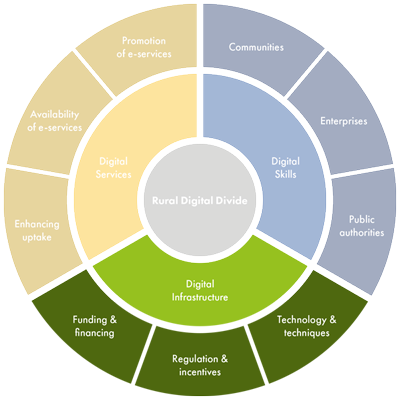Digital Infrastructure
The infrastructure dimension revolves around the development of superfast broadband infrastructure and its quality. Access to fast broadband-enabled services is a necessary condition for regional competitiveness especially in rural areas. To guarantee a future proof and complete coverage of superfast broadband services, several factors play a fundamental role. These include; fare competition, demand stimulation and uptake level, the availability of state aid and financial instruments, a decent regulatory framework, geographic and demographic characteristics, availability of ducts and upgradable networks as well as willingness to pay and affordability.
Results from CORA pilot and research activities will led to a set of strategic recommendations on best applied technologies and techniques for an efficient NGA extension in remote areas.

Technology & techniques

The availability of different broadband technologies is an important factor for a fast and qualitative expansion of broadband infrastructure, meeting different local needs occurring form topography and population structure. With DSL, cable access, the optical fibre technology, radio broadcasts and new mobile standards, a variety of technologies is available on the market that ensure reliable broadband services. However, it is important to choose a technology that is best for the individual region. In this context, many of the EU member states are aiming for a full coverage of fibre network, which is considered to be the future-proof technology.
Regulation, incentives & Leadership

When it comes to the involvement of local stakeholders and leadership, a crucial factor is that the responsible actors (usually at local level) feel that they are attached to the strategic targets and fully involved. Generally speaking, the involvement of local actors is especially important in rural areas, where there is a need for demand aggregation and bottom-up initiatives. Besides leadership, regulation plays a major role in facilitating the NGA roll-out. Examples are regulatory measures for increased use of alternative methods of deployment (e.g. micro- and mini-trenching, aerial deployment etc.), aggregated demand via special purpose associations or financial incentives such as vouchers or tax deductions. In this context, supportive funding schemes, digital agendas, shareholder constructions and demand subsidies play a major role for NGA extension.
Funding and finance

Although there is still significant private investment across Europe and the number of white spots decreases on a daily basis, some areas will hardly be commercially viable. Alternative funding schemes such as community based initiatives as well as public intervention are therefore often needed to close the digital divide. In this context, the European funds are an important cornerstone of many broadband projects and help to develop ICT-infrastructures, especially within rural areas with low commercial interest.
Rural areas have to provide appropriate incentives and means for increasing investment whilst local actors and the ICT industry need to make use of these instruments. Furthermore, public intervention should focus on reducing the cost of investment and, where necessary, provide public funding within the policy framework of national strategies, while making sure that private investment is not displaced.
A survey conducted by the University of Groningen for CORA identified several finance and business models in use in the participating European countries. Further details on business models, co-investments and funding possibilities will be provided throughout the project.

